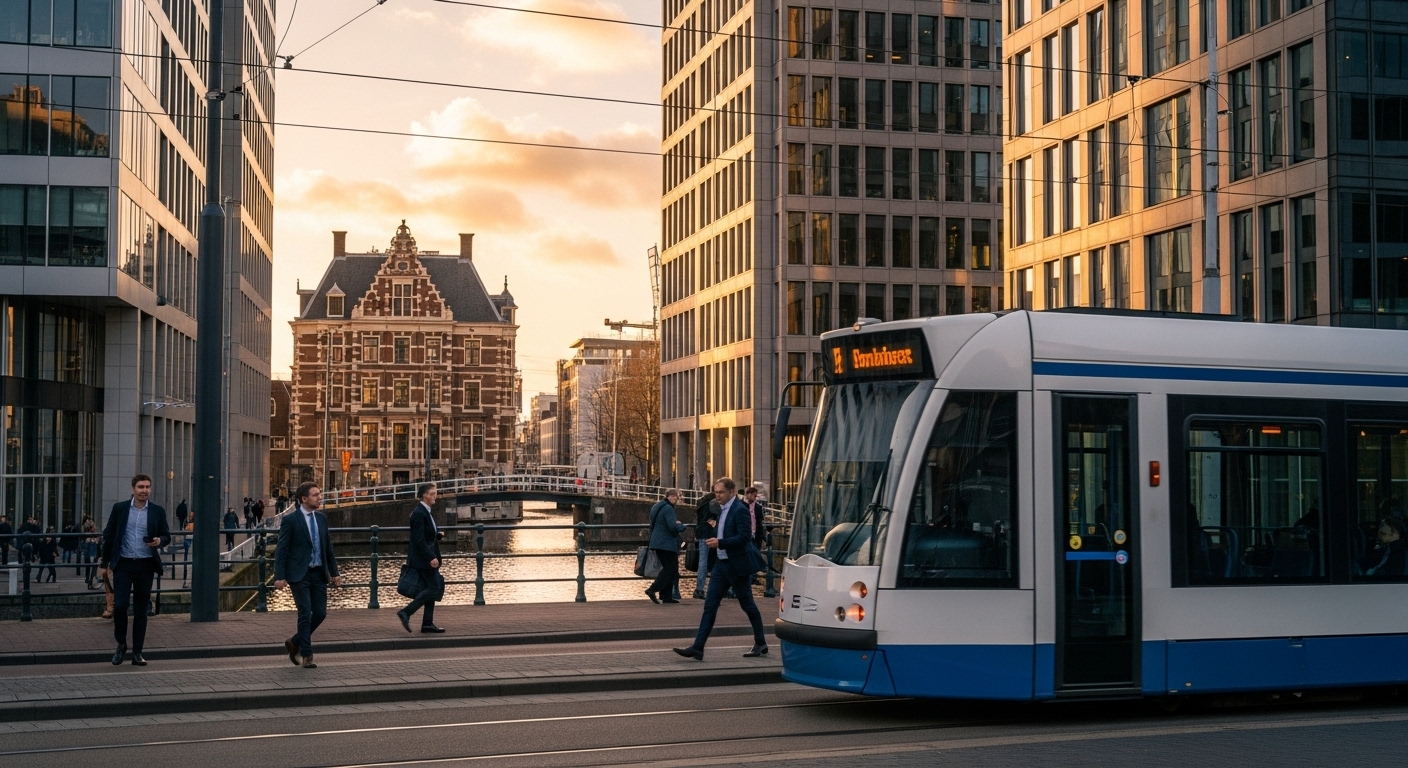In the grand tapestry of European commerce, few cities weave together historic charm and hyper-modern business acumen as seamlessly as Amsterdam. Long celebrated for its picturesque canals and rich cultural heritage, the city has decisively pivoted to become a formidable force in the continent’s economic landscape. Bolstered by a strategic post-Brexit repositioning, it has emerged as a magnet for multinational corporations, ambitious startups, and top-tier talent. This evolution is not happening by chance; it is anchored in the city’s meticulously planned and brilliantly executed business districts. From the soaring glass towers of Zuidas, the nation’s financial heart, to the repurposed industrial chic of Houthavens, a burgeoning creative hub, these districts are more than just collections of office buildings. They are integrated ecosystems built on pillars of unparalleled connectivity, a deep commitment to sustainability, and a vibrant, international talent pool. This article delves into the strategic advantages of these key districts, mapping how they collectively power the Dutch dynamo and solidify its position as a premier destination for global business.
The Zuidas: Europe’s Financial Powerhouse Reimagined
Often dubbed the ‘Financial Mile,’ Zuidas stands as the undisputed epicenter of the Netherlands’ financial and legal sectors. Situated strategically between the city center and Schiphol Airport, its skyline is a testament to architectural ambition and corporate power, hosting the headquarters and major offices of global giants in banking, consulting, and law. Yet, to label Zuidas as merely a collection of corporate headquarters would be to miss its ongoing transformation. Originally conceived as a monofunctional office park, it has evolved into a dynamic, mixed-use district. The master plan emphasizes a blend of living, working, and recreation, creating a vibrant urban environment that operates well beyond the traditional nine-to-five. This human-centric approach is visible in its public spaces, high-end residential towers, and growing collection of cafes, restaurants, and fitness centers. The World Trade Center Amsterdam, a cornerstone of the district, acts as a major hub, providing state-of-the-art facilities and fostering a collaborative business community. The district’s success lies in this deliberate fusion of high-stakes business with high-quality living, making it not just a place to work, but a desirable place to be. This evolution ensures Zuidas remains competitive, attracting not only established corporations but also the next generation of talent who demand more from their work environment than just a desk.
Connectivity as a Cornerstone: The Logistical Advantage
A city’s economic vitality is intrinsically linked to its arteries of transport and communication, and in this regard, Amsterdam’s business districts are exceptionally well-served. The logistical framework is a masterclass in efficiency, designed to connect businesses to the Netherlands, Europe, and the world with minimal friction. At the heart of this network is Amsterdam Airport Schiphol, one of Europe’s busiest and most connected airports, located just a six-minute train ride from Zuidas. This proximity offers unparalleled convenience for international business travel, making face-to-face meetings across continents remarkably feasible. Beyond air travel, the city’s rail infrastructure is robust, with high-speed trains linking it directly to Brussels, Paris, London, and major German cities. This ground-level connectivity makes the entire region feel like a local market. Digitally, the city is a global leader. It is home to one of the world’s largest internet exchanges, the Amsterdam Internet Exchange (AMS-IX), providing businesses with incredibly fast, reliable, and secure digital infrastructure. This digital backbone is a critical asset for the burgeoning tech scene and data-intensive industries that thrive within the business hubs of Amsterdam. This triple threat of air, rail, and digital connectivity forms a strategic advantage that is difficult to overstate, reducing operational friction and enabling businesses to operate at a global scale with local efficiency.
Houthavens and the Creative Boom: Where Innovation Meets Design
While Zuidas represents corporate might, Houthavens showcases Amsterdam’s creative soul. This former timber port, located on the banks of the IJ river, has undergone a dramatic metamorphosis into one of the city’s most exciting and design-forward business districts. The area has intentionally shunned the traditional corporate aesthetic, instead embracing its industrial heritage to create a unique and inspiring environment. Warehouses have been reborn as sleek, modern offices for media agencies, architectural firms, fashion brands, and tech startups. The architecture is bold and sustainable, with many buildings constructed on artificial islands, reflecting the Dutch mastery of water management and innovative design. What sets Houthavens apart is its atmosphere; it’s a district that feels more like a creative campus than a business park. The emphasis on community, collaboration, and work-life balance is palpable, with waterfront terraces, independent cafes, and public art installations fostering a sense of place and belonging. This environment is a powerful magnet for the creative industries, which thrive on inspiration and serendipitous encounters. Companies are drawn here not just for the stylish office spaces but for the access to a concentrated ecosystem of creative talent and like-minded innovators, making Houthavens a powerful engine for the city’s burgeoning creative economy.
The Sustainability Mandate: Building the Green Business Districts of Tomorrow
In an era where corporate responsibility is paramount, Amsterdam’s commitment to sustainability is a core component of its business appeal. This green ethos is not just a policy statement; it is physically built into the fabric of its business districts. The city is a pioneer in sustainable urban development, and areas like Zuidas are showcases for green building practices. A significant number of office buildings in the district have achieved high BREEAM (Building Research Establishment Environmental Assessment Method) certifications, a leading sustainability assessment method. These certifications reflect excellence in energy efficiency, water conservation, waste reduction, and the use of sustainable materials. Features like green roofs, smart climate control systems, and extensive cycling infrastructure are standard, not exceptions. This commitment extends beyond individual buildings to the district-wide level, with strategies for sustainable energy generation and a focus on public transport to reduce reliance on cars. For modern corporations, this is a powerful value proposition. A sustainable office is not only better for the planet but also a key factor in attracting and retaining top talent, particularly among younger generations who prioritize environmental values. By embedding sustainability into its commercial real estate, Amsterdam aligns its economic growth with its environmental ambitions, creating future-proof business districts that are both profitable and responsible.
Talent Magnetism: Cultivating a World-Class Workforce
Sophisticated infrastructure and prime real estate are crucial, but a business district’s true value lies in its people. On this front, Amsterdam excels, functioning as a powerful magnet for international talent. The city’s workforce is highly educated, famously multilingual—with over 90% of the population fluent in English—and culturally diverse. This creates a rich talent pool for companies looking to build international teams and serve global markets. The city’s exceptional quality of life is a major draw. Its vibrant culture, beautiful scenery, and progressive social values make it a highly desirable place to live. Furthermore, the Dutch work-life balance is renowned, emphasizing efficiency during work hours to allow ample time for personal pursuits. This combination of professional opportunity and personal well-being is a compelling package for skilled professionals from around the world. The city’s prestigious universities, such as the University of Amsterdam and Vrije Universiteit Amsterdam, provide a steady stream of well-trained graduates, particularly in fields like technology, finance, and data science. This symbiotic relationship between academia and industry ensures that the talent ecosystem within Amsterdam is not only deep but also constantly refreshing, giving businesses located here a sustainable competitive advantage in the global war for talent.
Sloterdijk and Beyond: The Future of Urban Business Development
The evolution of Amsterdam’s business landscape is a continuous process, and the transformation of Sloterdijk is a prime example of its forward-thinking urban strategy. For years, Sloterdijk was known primarily as a transportation hub surrounded by a somewhat sterile, monofunctional office park that emptied out after 5 p.m. Today, it is in the midst of a large-scale redevelopment designed to turn it into a vibrant, 24/7 mixed-use district. The vision is to add thousands of new homes, along with more restaurants, shops, and cultural venues, transforming it from a place people commute to into a place people live. This strategy addresses the changing demands of the modern workforce and creates a more resilient and dynamic urban area. This model of densification and diversification is not unique to Sloterdijk; it reflects a city-wide approach to smarter, more sustainable growth. By regenerating existing office parks rather than endlessly expanding outwards, the city preserves green space while creating more integrated and livable communities. This focus on urban renewal signals a mature and strategic approach to development, ensuring that as the city’s economy grows, its quality of life grows with it. For businesses, this means new opportunities in emerging locations that offer excellent connectivity and a fresh, modern environment, further diversifying the city’s portfolio of premier business locations.
Conclusion
Amsterdam’s ascent as a top-tier European business destination is a story of strategic vision and meticulous execution. The city has successfully cultivated a diverse portfolio of business districts, each with its own distinct character and competitive advantages. Zuidas stands as a formidable financial and legal hub, continuously evolving to meet the demands of modern corporate life. Houthavens offers a vibrant, design-led environment for the creative and tech industries, while emerging areas like Sloterdijk point towards a future of integrated, mixed-use urban development. Underpinning the success of all these districts are the city’s unwavering commitments to three core pillars: seamless global connectivity, ambitious sustainability goals, and the cultivation of a world-class, international talent pool. These elements combine to create a powerful and resilient economic ecosystem. For multinational corporations seeking a strategic European headquarters and for innovative startups looking for fertile ground to grow, the business districts of Amsterdam offer a compelling and comprehensive value proposition. The Dutch dynamo is not just powering its own future; it is helping to shape the future of business across the continent.





